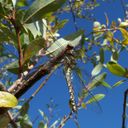Rhionaeschna
Rhionaeschna
Classification
- Phylum: Arthropoda
- Subphylum: Hexapoda
- Class: Insecta
- Order: Odonata
- Suborder: Anisoptera
- Family: Aeshnidae
- Genus: Rhionaeschna
Pronunciation
How to pronounce Rhionaeschna: /ˌraɪ.oʊˈnɛʃ.nə/
These audio files are automatically generated. While they are not always 100% accurate, they are a good starting point.
Images






Summary
Rhionaeschna is a genus of large dragonflies known as blue-eyed darners, recognized for their vibrant colors and predatory nature. They inhabit various aquatic environments across North America and play an integral role in local ecosystems.
Physical Characteristics
Members of the genus Rhionaeschna are characterized by their large size, prominent blue eyes, and striking coloration, which typically includes a combination of bright blues and greens.
Identification Tips
Look for their distinctive large, bright blue eyes and bold color patterns; often found near water bodies where they hunt.
Habitat
Rhionaeschna species are commonly found in wetland habitats, including lakes, ponds, and slow-moving rivers.
Distribution
The genus Rhionaeschna is primarily distributed across North America.
Diet
As predators, adult Rhionaeschna primarily feed on smaller insects, which they capture in flight.
Life Cycle
The lifecycle includes an aquatic nymph stage followed by metamorphosis into a terrestrial adult.
Reproduction
Females lay eggs in or near water, where the nymphs will hatch and develop under the water.
Predators
Adults may fall prey to larger birds and other predatory insects.
Ecosystem Role
They play a critical role as both predators of smaller insects and as prey for larger animals, maintaining ecological balance.
Cultural Significance
Dragonflies, including those in the genus Rhionaeschna, are often appreciated in culture for their beauty and role in ecosystems, but specific cultural references are not well documented.
Collecting Methods
- Netting with aerial nets near water bodies
- Manually capturing resting adults on vegetation
Preservation Methods
- Pinning specimens for display
- Storing in 70-95% ethanol for molecular studies
Misconceptions
Many people confuse Rhionaeschna dragonflies with similar species, particularly due to the overlapping habitats and physical features among the Aeshnidae family.
Tags
- dragonfly
- Odonata
- Aeshnidae
- Rhionaeschna
- blue-eyed darners